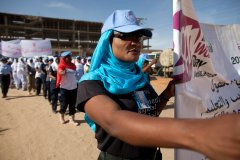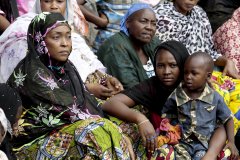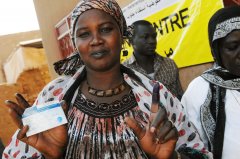Gender Issues Showlist
Women, Peace & Security
UNSCR 1325 calls on all parties to: protect and respect the rights of women and girls in conflict & post-conflict; increase women participation in all conflict resolution, peacekeeping and peace-building & to end impunity by prosecuting perpetrators of sexual and other violence on women and girls
index.php?option=com_content&view=category&id=56&Itemid=1913
Human Rights of Women
Thirty six years after the adoption of CEDAW, many women and girls still do not have equal opportunities to realize rights recognized by law. Women are denied the right to own property or inherit land. They face social exclusion, “honor killings”, FGM, trafficking, restricted mobility, early marriage,...
index.php?option=com_content&view=category&id=44&Itemid=1908
Violence Against Women
Violence against women is the most shameful human rights violation. Gender based violence not only violates human rights, but also hampers productivity, reduces human capital and undermines economic growth. It is estimated that up to 70 per cent of women experience violence in their lifetime
index.php?option=com_content&view=category&id=69&Itemid=1912
Political Participation & Leadership
Where women are fully represented, societies are more peaceful and stable. Women political participation is fundamental for gender equality and their representation in positions of leadership must be a priority for all Africans governments.
index.php?option=com_content&view=category&id=65&Itemid=1911
Latest News
- Ghana: Presidential and Parliamentary Elections
- Botswana: Parliamentary elections 2024
- Algeria: Presidential Election 2024
- Rwanda: Presidential and parliamentary elections 2024
- Madagascar Parliamentary Elections 2024
- Chad Presidential Election 2024
- Togo: Parliamentary elections 2024
- NAMIBIA: Nandi-Ndaitwah Elected As Namibia's First Woman President
- Islamic Republic of Mauritania Presidential Election 2024
- The Republic of South Africa: Parliamentary Elections 2024
AFRICA: Women And Sustainable Food Security
Soure: FAO
THE GENDER DIVISION OF LABOR
The major constraint to the effective recognition of women's actual roles and responsibilities in agriculture is the scarcity of gender desegregated data available to technicians, planners, and policy-makers.
Therefore, the first step towards women's empowerment and full participation in rural development and food security strategies is the collection and analysis of gender desegregated data to understand role differences in food and cash crop production as well as men's and women's differential managerial and financial control over production, storage and marketing of agricultural products.
In Sub-Saharan Africa, for example, micro-level studies have shown that women play a crucial role in many aspects of crop production. While men are often responsible for land clearing, burning and polishing, women specialise in weeding, transplanting, post-harvest work and, in some areas, land preparation and both take part in seeding and harvesting.
Moreover, Sub-Saharan and near Eastern women play a major role in household animal-production enterprises, where they tend to have the primary responsibility for the husbandry of small animals and ruminants, but also take care of large-animal systems, herding, providing water and feed, cleaning stalls and milking. In all types of animal-production systems, women have a predominant role in processing, particularly milk products and are commonly responsible for their marketing.
In many countries women are also responsible for fishing in shallow waters and in coastal lagoons, producing secondary crops, gathering food and firewood, processing, storing and preparing family food and for fetching water for the family.
FEMALE-HEADED HOUSEHOLDS
The number of female-headed households is increasing significantly in rural areas in many developing countries as rural men migrate due to the lack of employment and other income-generating opportunities. In Sub-Saharan Africa, 31 per cent of rural households are headed by women, while in Latin America and the Caribbean and Asia, women head 17 per cent, and 14 per cent, respectively. While there are different types of female-headed households, in almost all countries. female-headed households are concentrated among the poorer strata of society and often have lower income than male-headed households.
The problems of female-headed households in rural areas vary according to their degree of access to productive resources. The FAO has identified. for example, the potential consequences of the absence of male labour both in terms of declining yields and outputs or shifts in production toward less nutritious crops requiring less labour and in terms of increased reliance on child labour which, in turn, has further implications for the family and for the human capital of the country. Therefore in these cases, women's access to labour-saving technology is of particular importance.
Women produce between 60 and 80 per cent of the food in most developing countries and are responsible for half of the world's food production, yet their key role as food producers and providers and their critical contribution to household food security is only recently becoming recognised.
FAO studies confirm that while women are the mainstay of small-scale agriculture, farm labour force and day-to-day family subsistence, they have more difficulties than men in gaining access to resources such as land and credit and productivity enhancing inputs and services.
Food security' in fact, has been defined by the FAO not only in terms of access to, and availability of food, but also in terms of resource distribution to produce food and purchasing power to buy food where it is not produced. Given women's crucial role in food production and provision, any set of strategies for sustainable food security must address their limited access to productive resources security must address their limited access to productive resources.
Women's limited access to resources and their insufficient purchasing power are products of a series of interrelated social, economic and cultural factors that force them into a subordinate role, to the detriment of their own development and that of society as a whole.
The international initiatives and efforts developed especially since the 1975 World Conference on Women in Mexico have contributed to a greater recognition of women's key participation in rural and other domains of development, however, much remains to be done.
ACCESS TO RESOURCES
Despite their role as the backbone of food production and provision for family consumption in developing countries, women remain limited in their access to critical resources and services. While in most developing countries. both men and women farmers do not have access to adequate resources, women's access is even more limited due to cultural. traditional and sociological factors. Accurate information about men's and women's relative access to. and control over, resources is crucial in the development of food security strategies.
· Access to land. Not even 2 percent of land is owned by women. while the e proportion of women heads of household continues to grow. Land reform programmes together with the break-up of communal land holdings have led to the transfer of exclusive land rights to males as heads of households which ignores both the existence of female-headed households and the rights of married women to a joint share.
· Access to credit. For the countries where information is available. only 10 per women produce between 60 and 80 per cent of the food in cent of credit allowances is extended to women, mainly because national legislation and customary law do not allow them to share land property rights along with their husbands, or because women heads of household are excluded from land entitlement schemes and consequently cannot provide the collateral required by lending institutions.
· Access to agricultural inputs. Women's access to technological inputs such as improved seeds, fertilisers and pesticides is limited as they are frequently not reached by extension services and are rarely members of cooperatives, which often distribute government subsidised inputs to small farmers. In addition, they often lack the cash income needed to purchase inputs even when they are subsidised
· Access to education, training and extension services. Two thirds of the one billion illiterate in the world are women and girls. Available figures show that only 5 per cent of extension services has been addressed to rural women, while no more than 15 per cent of the world's extension agents are women. In addition, most of the extension services are focused on cash crops rather than food and subsistence crops, which are the primary concern of women farmers and the key to food security.
· Access to decision-making. Given the traditionally limited role of women in decision-making processes at the household, village and national levels in most cultures, their needs, interests and constraints are often not reflected in policymaking processes and laws which are important for poverty reduction, food security and environmental sustainability. The causes of women's exclusion from decision-making processes are closely linked to their additional reproductive roles and their household workload, which account for an important share of their time.
· Access to research and appropriate technology. Women have little access to the benefits of research and innovation, especially in the domain of food crops, which in spite of ensuring food security at the household and community level, have a low priority in crop improvement research. In addition, women farmers' roles and needs are often ignored when devising technology which may cause labour displacement or increased workload.
WOMEN'S NEED FOR INCOME
Research in Africa, Asia and Latin America has found that improvements in household food security and nutrition are associated with women's access to income and their role in household decisions on expenditure as women tend to spend a significantly higher proportion of their income than men on food for the family.
Women's wage income from farm and non-farm employment and from other income-generating opportunities is of particular importance for landless and near-landless rural households. Women's purchasing power may not only be used to buy food and other basic assets for themselves and their families, but also to pay for the inputs used in food production. Since food crops are consumed, the inputs for these have to be provided from income earned in other agricultural enterprises or non-farm income generating activities. Thus, to improve food production for the household, greater priority has to be given to increasing women's participation in market production as well as other income-generating ventures.
SUSTAINABLE FOOD SECURITY REQUIREMENTS FOR NEW ERA
The understanding of food security has evolved over the years through increasingly integrated attention to the social, gender, environmental. technical and economic dimensions of the problem. The challenge for the future will be to pursue a concrete attainment of equity in access to resources by women to produce food, and purchasing power to buy food where it is not produced there enhancing their potential to generate food security Specific policy measures are required to address the constraints facing women farmers and special consideration given en to the needs of female heads of households. The FAO has recommended that such measures aim to:
· ensure that women have equal opportunities with men to own land;
· facilitate women's access to agricultural services tailoring such services to their needs;
· encourage the productions of food crops through the use of incentives;
· promote the adoption of appropriate inputs and technology to free up Women's time for income-producing activities;
· improve the nutritional status of women and children;
· provide better employment and income earning opportunities;
· promote women's organizations;
· review and re-orient government policies to ensure that the problems that constrain the role of women in food security are addressed.





